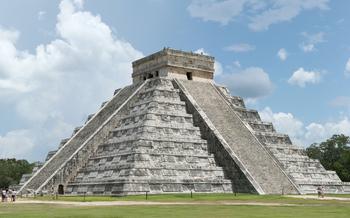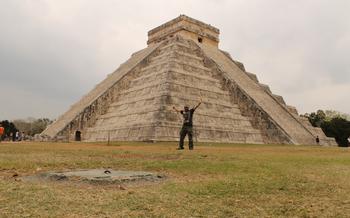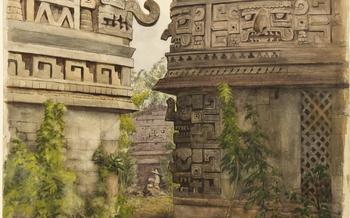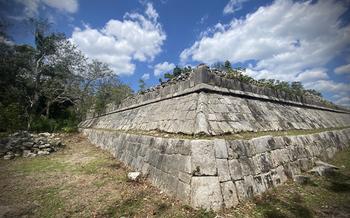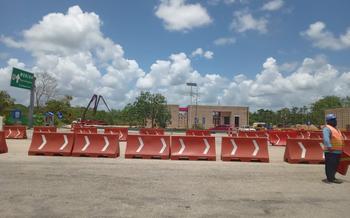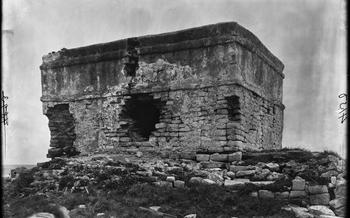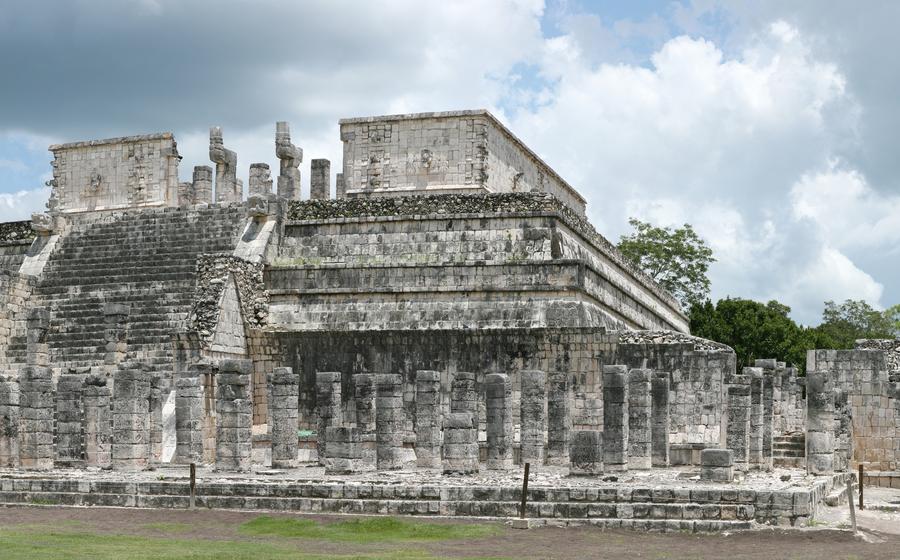
Temple of the Warriors
- The Temple of the Warriors in Chichen Itza: A Majestic Mayan Masterpiece
- Unraveling the History of the Temple: A Journey Through Time
- Exploring the Architectural Marvel: A Testament to Mayan Ingenuity
- Awe-Inspiring Murals and Reliefs: A Canvas of Mayan Legends
- The Temple's Sacred Purpose: A Place of Rituals and Ceremonies
- Echoes of Ancient Voices: The Temple's Acoustics
- A Walk Through Time: Exploring the Temple Complex
- The Temple in Popular Culture: A Symbol of Ancient Grandeur
- Tips for an Enriching Visit: Making the Most of Your Experience
- Unforgettable Photo Opportunities: Capturing the Temple's Grandeur
- Respecting the Temple and Its Cultural Significance
- Chichen Itza Beyond the Temple: Exploring the Ancient City
- Combining History with Adventure: Nearby Attractions
- Preserving the Legacy: Conservation Efforts at Chichen Itza
- Insider Tip: Unveiling Hidden Secrets
The Temple of the Warriors in Chichen Itza: A Majestic Mayan Masterpiece
In the heart of the ancient city of Chichen Itza, a majestic architectural wonder stands tall, a testament to the brilliance and ingenuity of the Mayan civilization. The Temple of the Warriors, a towering structure adorned with intricate carvings and reliefs, invites travelers to step back in time and immerse themselves in the rich history and culture of the Maya people.
This awe-inspiring temple, nestled amidst the lush tropical forests of the Yucatan Peninsula, is a masterpiece of Mayan architecture and design. Built in the 10th century, it served as a sacred ceremonial center, a place where the Maya conducted religious rituals and paid homage to their gods. The temple's imposing presence, its intricate details, and its unique features make it a must-visit destination for anyone seeking to explore the wonders of the ancient Mayan world.
To fully appreciate the grandeur of the Temple of the Warriors, it is essential to understand its history, significance, and architectural marvels. Let's embark on a journey through time, uncovering the secrets and stories that lie within this iconic Mayan masterpiece.
Unraveling the History of the Temple: A Journey Through Time
The Temple of the Warriors in Chichen Itza stands as a testament to the ingenuity and architectural prowess of the ancient Maya civilization. Its origins can be traced back to the 11th century, during the height of the Maya Classic period. Constructed by the Maya ruler Kukulcan, the temple served as a religious and ceremonial center, playing a pivotal role in the spiritual and cultural life of the Maya people.
The temple's design and iconography reflect the Maya's deep understanding of astronomy and mathematics. Its alignment with the sun during the spring and autumn equinoxes suggests that the temple was used for astronomical observations and timekeeping. The intricate carvings and bas-reliefs adorning the temple's facade depict scenes from Maya mythology, historical events, and religious rituals, providing a glimpse into the rich symbolism and beliefs of this ancient civilization.
The Maya civilization, which flourished in the Yucatán Peninsula and parts of Central America, left an indelible mark on the region. Their advanced knowledge of mathematics, astronomy, and architecture continues to inspire and amaze scholars and visitors alike. The Temple of the Warriors, with its imposing size, intricate carvings, and symbolic significance, stands as a symbol of the Maya's enduring legacy.
Exploring the Architectural Marvel: A Testament to Mayan Ingenuity
The Temple of the Warriors stands as a testament to the architectural prowess of the Maya civilization. Its imposing structure, measuring approximately 40 meters in height and 60 meters in width, dominates the landscape. The temple's most striking feature is its colonnade, or row of columns, which supports the temple's roof. These columns are adorned with intricate carvings depicting Mayan deities and mythological scenes.
Another unique feature of the temple is the Chac Mool sculpture, which is positioned at the top of the main staircase. This sculpture depicts a reclining figure with a bowl held in its hands. It is believed that this bowl was used to collect rainwater, which was considered sacred by the Maya.
The temple's alignment with the sun is another testament to the Maya's astronomical knowledge. The temple is positioned so that on the spring and autumn equinoxes, the sun rises directly over the temple's main staircase, creating a dramatic shadow effect.
The temple is also adorned with intricate carvings and bas-reliefs, which depict Mayan deities, historical events, and scenes from everyday life. These carvings provide valuable insights into the beliefs, customs, and culture of the Maya civilization.
Awe-Inspiring Murals and Reliefs: A Canvas of Mayan Legends
The Temple of the Warriors is adorned with a remarkable collection of murals and bas-reliefs, which offer a glimpse into the rich mythology and history of the Maya civilization. These vibrant and well-preserved artworks depict scenes from Mayan mythology, historical events, and everyday life.
The murals and bas-reliefs on the temple's walls showcase the exceptional artistry and symbolism of the Maya. They feature intricate depictions of Mayan deities, such as the rain god Chaac and the maize god Yum Kax, as well as scenes of warfare, trade, and daily life. The murals and reliefs also incorporate hieroglyphic texts, providing valuable insights into Mayan history and culture.
One of the most striking features of the Temple of the Warriors is the series of murals depicting a battle scene. These murals showcase the Maya's prowess in warfare and their intricate armor and weapons. Another notable mural depicts a procession of Maya nobles and warriors, offering a glimpse into the social hierarchy and political structure of the Mayan empire.
The bas-reliefs on the temple's facade are equally impressive. They depict a variety of subjects, including scenes from Mayan mythology, historical events, and everyday life. One of the most iconic bas-reliefs depicts a procession of Maya warriors, each carrying a spear and shield. Another bas-relief shows a Maya ruler seated on a throne, surrounded by his court.
The murals and bas-reliefs of the Temple of the Warriors are a testament to the artistic skill and cultural richness of the Maya civilization. They offer visitors a unique opportunity to learn about Mayan mythology, history, and way of life, and to appreciate the beauty and complexity of Maya art.
The Temple's Sacred Purpose: A Place of Rituals and Ceremonies
The Temple of the Warriors served as a sacred site for the Maya, where they performed religious ceremonies and rituals to honor their gods and seek their favor. The temple's alignment with the sun during the spring and fall equinoxes held great significance, as it marked the beginning of the agricultural seasons. During these times, the Maya would gather at the temple to celebrate the equinoxes and pray for a bountiful harvest.
In addition, the temple was used for astronomical observations. The Maya were skilled astronomers, and they used the temple's alignment with the sun and stars to track the passage of time and create their intricate calendar system. The temple's positioning allowed them to accurately predict celestial events, such as eclipses and solstices, which played a crucial role in their agricultural practices and religious rituals.
The temple also held spiritual significance for the Maya. They believed that the temple was a place where they could communicate with the gods and seek their guidance. The temple's elaborate carvings and iconography were designed to represent the Maya's spiritual beliefs and to create a sacred space for their religious practices.
Echoes of Ancient Voices: The Temple's Acoustics
The Temple of the Warriors boasts exceptional acoustics that add to its mystique and allure. The phenomenon of the "clapping echo" is a testament to the ingenuity of the Maya builders. When a person claps their hands in front of the temple, a distinct echo reverberates, resembling a sharp clap. This effect is attributed to the temple's specific architectural design, with its sloping walls and vaulted ceilings acting as natural amplifiers.
The Maya architects understood the principles of sound reflection and utilized them to create a unique acoustic experience. The temple's acoustics played a crucial role in religious ceremonies and rituals. The reverberating echoes may have been seen as a sign of divine presence or a way for the Maya to communicate with their gods. The temple's acoustics also served a practical purpose, enabling priests to project their voices and ensure that their messages were heard by the entire congregation.
The Temple of the Warriors stands as a testament to the Maya people's advanced understanding of acoustics. Their ability to harness the power of sound for both religious and practical purposes showcases their ingenuity and their deep connection to the natural world.
A Walk Through Time: Exploring the Temple Complex
Beyond the Temple of the Warriors, the sprawling complex of Chichen Itza is a treasure trove of ancient structures, each with its own unique story to tell. As you wander through the complex, you'll encounter a myriad of awe-inspiring buildings that once served various purposes in Mayan society.
One of the most prominent structures is the Great Ball Court, the largest in Mesoamerica. This colossal court, measuring over 500 feet in length, was the stage for the Mesoamerican ballgame, a ritual sport that held deep cultural and religious significance. The court's acoustics are particularly impressive, allowing the sound of a ball hitting the wall to be heard throughout the entire complex.
Another intriguing structure is the Temple of the Skulls, named for the gruesome carvings that adorn its facade. These carvings depict severed heads, a reminder of the temple's association with human sacrifice, a practice that was central to Mayan religious beliefs.
Finally, no visit to Chichen Itza would be complete without exploring the Cenote Sagrado, a natural sinkhole that was considered a sacred site by the Maya. This cenote, with its crystal-clear waters, was used for religious ceremonies and rituals, including offerings to the rain god Chaac.
The Temple in Popular Culture: A Symbol of Ancient Grandeur
The Temple of the Warriors has transcended its historical significance to become a prominent symbol of ancient grandeur, not just in Mexico but worldwide. Its captivating presence has influenced various forms of popular culture, making it a recognizable icon of the Mayan civilization.
The temple has been featured in numerous movies, capturing the imagination of audiences worldwide. From the epic "Apocalypto" to the animated film "The Road to El Dorado," the temple's imposing structure has provided a backdrop for thrilling adventures and historical narratives.
Television shows have also embraced the temple's allure. The popular series "Ancient Aliens" dedicated an episode to the temple, exploring its potential connection to extraterrestrial beings. The History Channel's "America's Lost Treasures" featured the temple, unraveling its mysteries and highlighting its significance in Mayan history.
Beyond the screen, the temple has also left its mark on literature. Fantasy novels such as "The Mayan Codex" by Clive Cussler and "The Jaguar Throne" by Isabel Allende have incorporated the temple into their plots, weaving tales of adventure and intrigue set against the backdrop of the ancient Mayan world.
The temple's influence extends to modern-day art and architecture as well. Artists have drawn inspiration from its intricate carvings and bas-reliefs, incorporating Mayan motifs into their works. Architects have looked to the temple's design principles, using them as a source of inspiration for contemporary buildings.
The temple's portrayal in popular culture has played a crucial role in promoting cultural heritage and tourism. Its presence in movies, TV shows, and literature has piqued the interest of people worldwide, encouraging them to visit Chichen Itza and experience the grandeur of the Mayan civilization firsthand.
Tips for an Enriching Visit: Making the Most of Your Experience
Planning your visit to the Temple of the Warriors in Chichen Itza requires careful consideration to create an enriching and unforgettable experience. Here are some essential tips to make the most of your exploration:
Plan Your Visit:
-
Timing is Key: Choose the right time of day for your visit. Early morning or late afternoon offers the best lighting conditions for photography and a more pleasant temperature to explore the site.
-
Avoid Crowds: If possible, plan your visit during the shoulder season (May-June or September-October) to avoid the peak tourist crowds.
-
Hire a Guide: Consider hiring a knowledgeable guide to enhance your experience. They can provide insights into the temple's history, significance, and Mayan culture.
Be Prepared:
-
Comfortable Footwear: Wear comfortable shoes suitable for walking on uneven surfaces as you will be exploring the temple complex on foot.
-
Sun Protection: The Yucatan sun can be intense, so wear sunscreen, sunglasses, and a hat to protect yourself from the heat and UV rays.
-
Hydration: Stay hydrated by bringing a water bottle or purchasing one from the vendors at the site.
-
Respect the Temple: Observe proper etiquette and dress code when visiting the temple. Avoid wearing revealing or disrespectful clothing, and refrain from climbing or touching the temple's structures.
-
Photography Etiquette: Use natural light for your photos to preserve the murals and carvings. Avoid using flash photography, as it can damage the delicate artwork.
-
Cultural Sensitivity: Be mindful of the temple's sacredness and its importance to the Maya people. Respect their traditions and customs, and refrain from engaging in any disrespectful behavior.
Unforgettable Photo Opportunities: Capturing the Temple's Grandeur
The Temple of the Warriors presents photographers with a wealth of captivating angles and vistas. To capture the temple's towering presence, position yourself at a distance and utilize a wide-angle lens. This technique accentuates the temple's grandeur against the backdrop of the sprawling complex. Experiment with different vantage points to create dynamic compositions.
Harness the power of natural light to enhance your photographs. The golden hues of sunrise and sunset bathe the temple in a warm glow, creating a magical atmosphere. These times of day offer exceptional lighting conditions for capturing the temple's intricate details and textures.
Compose your shots carefully to highlight the temple's unique features. Focus on the intricate carvings, bas-reliefs, and sculptures that adorn the temple's facade. Experiment with different angles to create dramatic perspectives and draw attention to specific elements.
Beyond the temple itself, capture the essence of the surrounding environment. Photograph the lush vegetation, the ancient ball court, and the sacred cenote. These elements contribute to the temple's mystique and provide a glimpse into the vibrant world of the Maya civilization.
Respecting the Temple and Its Cultural Significance
When visiting the Temple of the Warriors, it is essential to be respectful of its cultural significance and the sacredness it holds for the Maya people. Proper etiquette and dress code should be observed, ensuring that visitors are appropriately dressed and behave in a manner that is respectful of the site's religious and cultural importance. Climbing or touching the temple's structures is prohibited to preserve the integrity of the ancient ruins. Flash photography should also be avoided to prevent damage to the delicate murals and bas-reliefs. Visitors should be mindful of the temple's spiritual significance and its importance to the Maya people, respecting their traditions and beliefs. By adhering to these guidelines, visitors can contribute to the preservation of this sacred site and ensure that future generations can continue to appreciate its beauty and cultural value.
Chichen Itza Beyond the Temple: Exploring the Ancient City
While the Temple of the Warriors stands as the centerpiece of Chichen Itza, the ancient city offers a wealth of other captivating structures and ruins to explore. Step beyond the temple and immerse yourself in the rich history and cultural heritage of the Mayans.
Visit the Great Ball Court, one of the largest and best-preserved ball courts in the Maya world. Witness the grandeur of the Temple of Kukulkan, also known as El Castillo, and marvel at its architectural prowess. Explore the Temple of the Skulls, with its eerie collection of human skulls, and learn about the macabre rituals that took place within its walls.
Wander through the residential areas of the ancient city, where you can see the remains of houses, workshops, and temples. Imagine the daily lives of the Maya people as you walk among these ruins.
Don't miss the Cenote Sagrado, a natural sinkhole that was considered a sacred site by the Mayans. Learn about the rituals and ceremonies that took place here, and marvel at the beauty of the cenote's crystal-clear waters.
By exploring beyond the Temple of the Warriors, you'll gain a deeper understanding of the Maya civilization and the incredible city they built. Immerse yourself in the history, culture, and natural beauty of Chichen Itza, and create memories that will last a lifetime.
Combining History with Adventure: Nearby Attractions
Beyond the captivating Temple of the Warriors, Chichen Itza offers a wealth of additional attractions that complement the historical experience. Just a short distance away, visitors can immerse themselves in the refreshing waters of the nearby cenotes, natural sinkholes that provide a unique opportunity to swim and explore the subterranean world. The nearby colonial city of Valladolid is another must-see, offering a glimpse into Mexican culture with its colorful streets, charming architecture, and delicious cuisine.
For those seeking adventure and natural beauty, the Yucatan Peninsula is a treasure trove of hidden gems. From exploring the ancient ruins of Tulum, perched on a dramatic cliff overlooking the Caribbean Sea, to marveling at the awe-inspiring stalactites and stalagmites of the Rio Secreto underground river, there's no shortage of breathtaking sights to discover. By combining the rich history of Chichen Itza with the diverse attractions of the surrounding region, travelers can create a well-rounded itinerary that offers a truly unforgettable experience.
Preserving the Legacy: Conservation Efforts at Chichen Itza
The preservation of Chichen Itza, a UNESCO World Heritage Site, is of utmost importance to protect its cultural and historical significance. Conservation efforts aim to safeguard the ancient ruins from the ravages of time, environmental factors, and human impact.
The Instituto Nacional de Antropología e Historia (INAH), Mexico's leading cultural heritage institution, plays a crucial role in the conservation of Chichen Itza. INAH's team of experts conducts ongoing research, restoration projects, and monitoring to ensure the site's integrity.
Conservation efforts at Chichen Itza involve various measures, including structural reinforcement, archaeological excavations, and the use of innovative technologies. INAH utilizes advanced techniques such as laser scanning and 3D modeling to document and preserve the site's intricate details.
One of the key challenges in preserving Chichen Itza is the impact of tourism. While tourism brings economic benefits to the region, it also poses risks to the ancient structures. INAH implements sustainable tourism practices, such as limiting visitor numbers, enforcing strict guidelines, and raising awareness among tourists about the importance of responsible behavior.
By supporting organizations dedicated to the preservation of Chichen Itza, such as the World Monuments Fund and the National Geographic Society, travelers can contribute to the conservation efforts. These organizations provide funding, expertise, and advocacy to ensure the legacy of this ancient city endures for future generations.
As responsible travelers, we can all play a role in preserving Chichen Itza by following guidelines, respecting the site's cultural significance, and promoting responsible tourism practices. Together, we can ensure that this awe-inspiring wonder of the Maya civilization continues to captivate and inspire visitors for generations to come.
Insider Tip: Unveiling Hidden Secrets
Beyond the well-trodden paths of the Temple of the Warriors, there lies a world of hidden secrets waiting to be discovered. For those willing to venture off the beaten track, the temple complex reveals a treasure trove of lesser-known areas that offer a glimpse into the hidden depths of Mayan history and culture.
Explore the secluded corners of the temple, where intricate carvings and symbols whisper tales of forgotten rituals and ancient beliefs. Seek out the hidden chambers and passageways that lead to secret altars and sanctuaries, where the Maya once performed sacred ceremonies and communed with their gods.
To unlock the full potential of your exploration, consider seeking out local guides who possess insider knowledge and stories that bring the temple's hidden secrets to life. These guides, often steeped in the traditions and lore of the Maya, can provide a unique perspective that transforms your visit into a truly immersive and unforgettable experience.
So, as you stand before the Temple of the Warriors, remember that there is more to discover than meets the eye. Embrace the spirit of adventure, let curiosity be your guide, and uncover the hidden treasures that await those who dare to look beyond the obvious.
